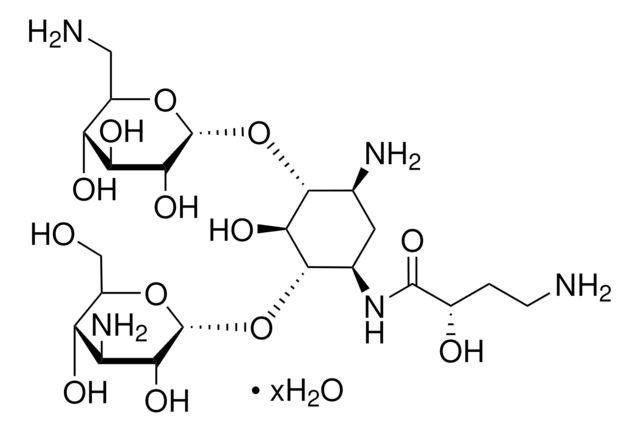K0879
Kanamycin -sulfat aus Streptomyces kanamyceticus
powder, γ-irradiated
Synonym(e):
Kanamycin A
About This Item
Empfohlene Produkte
Biologische Quelle
Streptomyces kanamyceticus
Qualität
for molecular biology
Sterilität
γ-irradiated
Form
powder
Wirksamkeit
≥700 μg per mg
Farbe
white to off-white
pH-Wert
6.5-8.5(1% solution)
Wirkungsspektrum von Antibiotika
Gram-negative bacteria
Gram-positive bacteria
mycoplasma
Wirkungsweise
protein synthesis | interferes
Lagertemp.
2-8°C
Eignung
nonselective for Escherichia coli
nonselective for coliforms
SMILES String
OS(O)(=O)=O.NC[C@H]1O[C@H](O[C@@H]2[C@@H](N)C[C@@H](N)[C@H](O[C@H]3O[C@H](CO)[C@@H](O)[C@H](N)[C@H]3O)[C@H]2O)[C@H](O)[C@@H](O)[C@@H]1O
InChI
1S/C18H36N4O11.H2O4S/c19-2-6-10(25)12(27)13(28)18(30-6)33-16-5(21)1-4(20)15(14(16)29)32-17-11(26)8(22)9(24)7(3-23)31-17;1-5(2,3)4/h4-18,23-29H,1-3,19-22H2;(H2,1,2,3,4)/t4-,5+,6-,7-,8+,9-,10-,11-,12+,13-,14-,15+,16-,17-,18-;/m1./s1
InChIKey
OOYGSFOGFJDDHP-KMCOLRRFSA-N
Suchen Sie nach ähnlichen Produkten? Aufrufen Leitfaden zum Produktvergleich
Allgemeine Beschreibung
Anwendung
Biochem./physiol. Wirkung
Widerstandsweise: Aminoglycosid-modifizierende Enzyme (einschließlich Acetyltransferase, Phosphotransferase, Nukleotidyltransferase) können dieses Antibiotikum verändern und dessen Wechselwirkung mit Ribosomen verhindern.
Antimikrobielles Spektrum: Kanamycinsulfat ist wirksam gegen gramnegative und grampositive Bakterien und Mycoplasma.
Prinzip
Angaben zur Herstellung
Ähnliches Produkt
Signalwort
Danger
H-Sätze
P-Sätze
Gefahreneinstufungen
Repr. 1B
Lagerklassenschlüssel
6.1C - Combustible acute toxic Cat.3 / toxic compounds or compounds which causing chronic effects
WGK
WGK 2
Persönliche Schutzausrüstung
Eyeshields, Gloves, type N95 (US)
Analysenzertifikate (COA)
Suchen Sie nach Analysenzertifikate (COA), indem Sie die Lot-/Chargennummer des Produkts eingeben. Lot- und Chargennummern sind auf dem Produktetikett hinter den Wörtern ‘Lot’ oder ‘Batch’ (Lot oder Charge) zu finden.
Besitzen Sie dieses Produkt bereits?
In der Dokumentenbibliothek finden Sie die Dokumentation zu den Produkten, die Sie kürzlich erworben haben.
Kunden haben sich ebenfalls angesehen
Unser Team von Wissenschaftlern verfügt über Erfahrung in allen Forschungsbereichen einschließlich Life Science, Materialwissenschaften, chemischer Synthese, Chromatographie, Analytik und vielen mehr..
Setzen Sie sich mit dem technischen Dienst in Verbindung.








